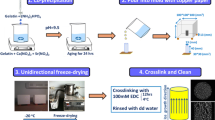Abstract
The problem of producing biodegradable implants based on calcium phosphate porous ceramics is being solved. Highly porous ceramics with a uniform distribution of pores of a specified size is fabricated by slip casting from a suspension containing tricalcium phosphate Ca3(PO4)2 and polymeric granules 50–100 μm in size in amounts of 20 and 50 vol %, respectively, followed by heat treatment. For the chosen sintering parameters, the porosity of the ceramics is not lower than 40% and its tensile strength and biocompatibility satisfy the corrsponding requirements.




Similar content being viewed by others
REFERENCES
S. M. Barinov, “Ceramic and composite materials based on calcium phosphates for medicine,” Usp. Khim. 79, No. 1, 15–32 (2010).
L. L. Hench and I. Thompson, “Twenty-first century challenges for biomaterials,” J. R. Soc. Interface 7 (4), 379–391 (2010).
M. Navarro, A. Michiardi, O. Castano, and J. Planell, “Biomaterials in orthopaedics,” J. R. Soc. Interface 5 (27), 1137–1158 (2008).
M. Bohner and J. Lemaitre, “Can bioactivity be tested in vitro with SBF solution?”, Biomaterials 30 (12), 2175–2179 (2009).
T. Albrektsson and C. Johansson, “Osteoinduction, osteoconduction and osseointegration,” Eur. Spine J. 10, 96–101 (2001).
S. J. Simske, R. A. Ayers, T. A. Bateman, “Porous materials for bone engineering,” Mater. Sci. Forum 250, 151–182 (1997).
X. Wang, S. Xu, S. Zhou, W. Xu, M. Leary, P. Choong, M. Qian, M. Brandt, Y. M. Xie, “Topological design and additive manufacturing of porous metals for bone scaffolds and orthopaedic implants: a review,” Biomaterials 83, 127–141 (2016).
K. A. Hing, “Bioceramic bone graft substitutes: influence of porosity and chemistry,” Int. J. Appl. Ceram. Technol. 2 (3), 184–199 (2005).
K. A. Hing, “Bone repair in the twenty-first century: biology, chemistry or engineering,” Philos. Trans. R. Soc. A: Math., Phys. Eng. Sci. 362 (1825), 2821–2850 (2004).
R. Gauvin, Y.-C. Chen, J. W. Lee, R. Soman, P. Zorlutuna, J. W. Nichol, H. Bae, Sh. Chen, and A. Khademhosseini, “Microfabrication of complex porous tissue engineering scaffolds using 3D projection stereolithography,” Biomaterials 33 (15), 3824–3834 (2012).
O. Lyckfeldt and J. M. F. Ferreira, “Processing of porous ceramics by ‘starch consolidation’,” J. Eur. Ceram. Soc. 18 (2), 131–140 (1998).
R. Liu, T. Xu, and C. Wang, “A review of fabrication strategies and applications of porous ceramics prepared by freeze-casting method,” Ceram. Int. 42 (2), 2907–2925 (2016).
U. Deisinger, “Generating porous ceramic scaffolds processing and properties,” Key Eng. Mater. 441, 155–179 (2010).
C. Galassi, “Processing of porous ceramics piezoelectric materials,” J. Eur. Ceram. Soc. 26 (14), 2951–2958 (2006).
M. Khodaei, A. Valanezhad, and I. Watanabe, “Fabrication and characterization of porous β-tricalcium phosphate scaffold for bone regeneration,” J. Environ. Friendly Mater. 2 (2), 1–4 (2018).
N. Koç, M. Timuçin, and F. Korkusuz, “Fabrication and characterization of porous tricalcium phosphate ceramics,” Ceram. Int. 30 (2), 205–211 (2004).
P. S. Eggli, W. Muller, and R. K. Schenk, “Porous hydroxyapatite and tricalcium phosphate cylinders with two different pore size ranges implanted in the cancellous bone of rabbits. A comparative histomor-phometric and histologic study of bony ingrowth and implant substitution,” Clin. Orthopaed. 232, 127–138 (1988).
ACKNOWLEDGMENTS
Experiments were carried out using the equipment purchased in the framework of a development program for Moscow State University.
Funding
This work was supported by the Russian Science Foundation, project no. 18-79-00256.
Author information
Authors and Affiliations
Corresponding author
Additional information
Translated by E. Yablonskaya
Rights and permissions
About this article
Cite this article
Tikhonova, S.A., Evdokimov, P.V., Prosvirnin, D.V. et al. Fabrication of Calcium Phosphate Bioceramics with a Uniform Distribution of Pores of a Given Size. Russ. Metall. 2021, 381–385 (2021). https://doi.org/10.1134/S0036029521040339
Received:
Revised:
Accepted:
Published:
Issue Date:
DOI: https://doi.org/10.1134/S0036029521040339




